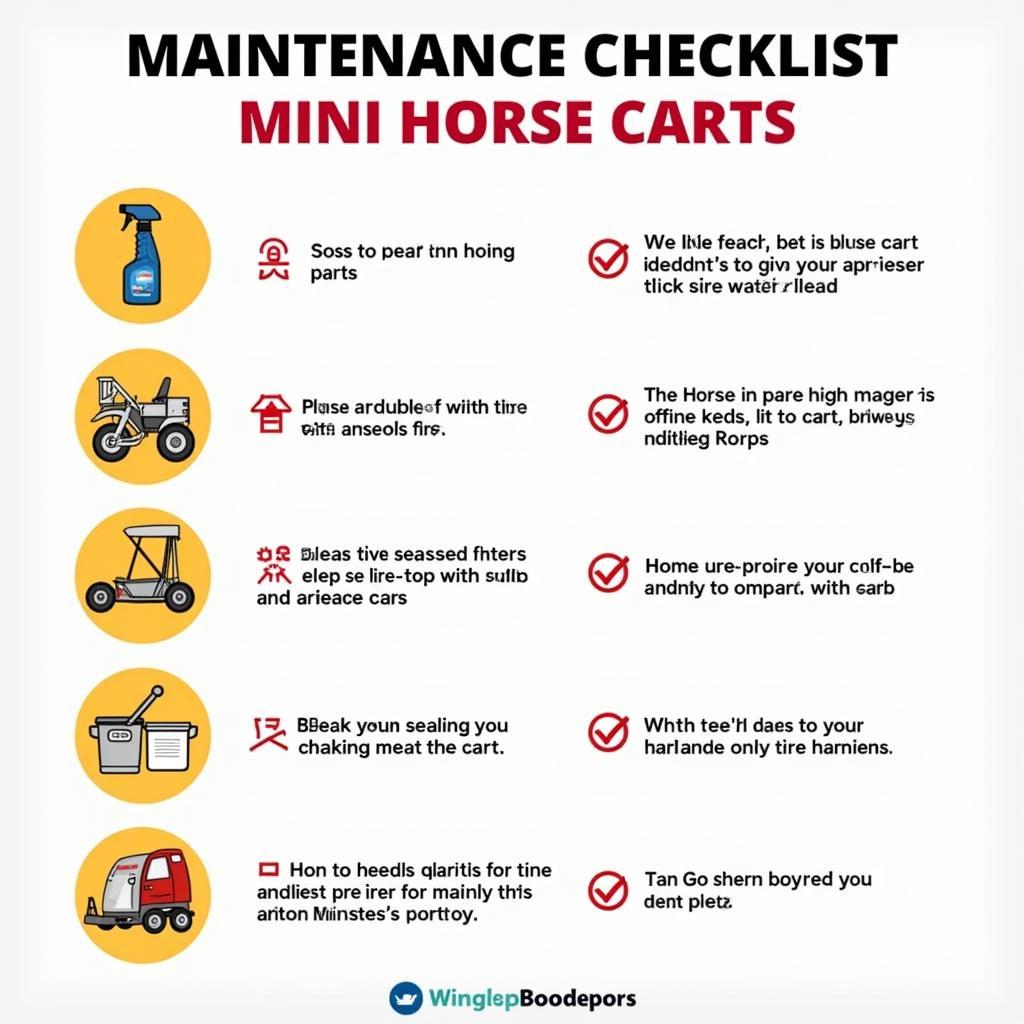Mini Horse Carts offer a delightful way to enjoy the company of your miniature equine companion. Whether you’re looking for a leisurely drive around the property or planning to participate in competitive driving events, selecting the right cart is crucial for both your horse’s well-being and your driving pleasure. This guide will delve into the essential aspects of choosing mini horse carts, ensuring a safe and enjoyable experience for both horse and driver.
Types of Mini Horse Carts
Miniature horse carts come in a variety of styles, each designed for a specific purpose and driving style. Understanding the different types available is the first step in making an informed decision. Some common types include:
- Easy Entry Carts: These carts are designed with a low step-in height, making it easier for drivers with mobility limitations to enter and exit.
- Show Carts: Show carts prioritize elegance and aesthetics, often featuring intricate detailing and polished finishes. They are specifically designed for showcasing miniature horses in competitions and exhibitions.
- Pleasure Carts: Built for recreational driving, pleasure carts emphasize comfort and durability, ideal for leisurely rides around the farm or park.
- Combination Carts: Offering versatility, combination carts can be configured for both pleasure driving and showing.
Key Considerations When Choosing Mini Horse Carts
Beyond the basic types, several factors play a vital role in selecting the perfect mini horse cart.
Size and Fit
Proper fit is paramount for your miniature horse’s comfort and safety. The cart should be proportionate to the horse’s size, ensuring it’s neither too large nor too small. A poorly fitting cart can lead to discomfort, sores, and even injuries.
Weight and Construction
Opt for a cart constructed from durable, lightweight materials. A heavy cart can strain your miniature horse, especially during longer drives. Consider materials like aluminum or fiberglass, which offer strength without excessive weight.
Wheel Size and Type
The size and type of wheels impact the cart’s performance and maneuverability. Larger wheels generally provide a smoother ride over uneven terrain. Pneumatic tires offer better shock absorption compared to solid rubber tires.
Safety Features
Safety should always be a top priority. Look for carts with features like brakes, seatbelts, and reflective strips for enhanced visibility.
Budget
Mini horse carts range in price from a few hundred dollars to several thousand, depending on the type, features, and materials. Determine your budget beforehand and prioritize essential features over cosmetic upgrades.
Matching Your Mini Horse Carts to Your Needs
The ideal mini horse cart depends on your specific needs and driving style. Consider the following questions:
What Will You Use the Cart For?
Will you be primarily using the cart for pleasure driving, showing, or both? Your intended use will dictate the type of cart that best suits your needs.
What is Your Driving Experience?
If you’re a beginner, a simple, easy-to-handle cart is recommended. More experienced drivers may prefer carts with advanced features and maneuverability.
What is Your Budget?
Set a realistic budget before you start shopping. This will help you narrow down your options and avoid overspending.
“A well-chosen cart is an investment in both your and your miniature horse’s enjoyment,” says renowned miniature horse expert, Dr. Amelia Cartwright. “Take your time, do your research, and choose wisely.”
Maintaining Your Mini Horse Carts
Regular maintenance is essential to ensure the longevity and safety of your mini horse cart. Keep all moving parts lubricated, check the tires for wear and tear, and store the cart in a dry, protected area.
“Regular maintenance is crucial for preventing costly repairs and ensuring a safe driving experience,” advises experienced carriage driver, Mr. Johnathan Miller.
 Miniature Horse Cart Maintenance Checklist
Miniature Horse Cart Maintenance Checklist
Conclusion
Choosing the right mini horse carts is a significant decision that requires careful consideration. By understanding the different types available, considering key factors like size, weight, and safety features, and aligning your choice with your specific needs and budget, you can ensure a safe, comfortable, and enjoyable driving experience for both you and your miniature equine companion. Remember, a well-chosen mini horse cart is an investment in years of shared enjoyment.
FAQ
- What is the average lifespan of a mini horse cart?
- How often should I lubricate the wheels of my mini horse cart?
- What are the best materials for mini horse cart construction?
- Are there specific regulations for using mini horse carts on public roads?
- What safety precautions should I take when driving a mini horse cart?
- Where can I find reputable dealers of mini horse carts?
- What is the weight limit for a mini horse cart?
For any assistance, please contact us at Phone Number: 0772127271, Email: [email protected] or visit us at QGM2+WX2, Vị Trung, Vị Thuỷ, Hậu Giang, Vietnam. We have a 24/7 customer support team.
You may also find helpful information in these related articles on our website:
- Choosing the Right Harness for Your Miniature Horse
- Miniature Horse Care Guide
- Training Your Miniature Horse for Driving
“Investing in a well-fitting and appropriate mini horse cart not only ensures the comfort and safety of your miniature horse but also enhances the overall driving experience,” adds experienced farrier and equine specialist, Ms. Sarah Johnson.